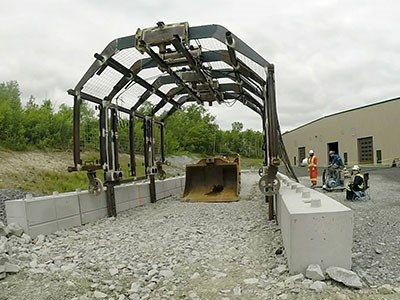The Centre of Excellence in Mining Innovation (CEMI) has completed the first phase of testing for a protective canopy system designed to serve as a key enabler for rapid underground development.
Two steel canopies – one providing protection for a jumbo, the other for bolting – allow drilling, loading and ground support installation to be performed simultaneously. The 7.5- metre-long canopy over the jumbo provides temporary protection against falling rock during drilling and loading while the five-metre-long canopy behind it protects miners installing screen and rebar.
Both canopies are equipped with hydraulics to enable vertical and lateral expansion, facilitating mobilization and positioning of the canopy close to the walls and back of the drift. Once the drilling, loading and bolting are complete, the canopy nearest the face is retracted and a loader pulls it through the bolting canopy to create a safe distance from the blast.
Using current underground development methodology, ground support installation and drilling are performed sequentially, allowing the jumbo operator to work safely under supported ground. But this slows development and requires constant jockeying of jumbos, bolters and loaders to the face.
Other aspects of the rapid development system envisioned by CEMI still being researched include a continuous mucking solution, a redesigned jumbo with a third boom for explosives loading and a narrow crusher which would be installed at some point along a still to be determined material conveyance system.
Rapid development is becoming more and more important as mines get older and deeper, said Harvey Parsons, CEMI vice-president for mine productivity.
“We need to get down there and get at the ore as quickly as possible for it to be profitable,” he said.
The canopies were built by Mining Technologies International (MTI), which has since been acquired by Joy Global, and tested at the former MTI underground test mine, which was not part of the transaction.
CEMI engaged Labreque Technologies to perform simulation analysis to estimate the amount of time saved by using the canopies. “We made a lot of assumptions, so testing was necessary to confirm they would work the way we designed them,” said CEMI R&D program director Seppo Haapamaki.
Testing was done to determine how long it would take to expand and collapse the canopies and move them into and out of position on a 15 per cent grade.
“Every test was done 10 times, video recorded and time stamped,” said Haapamaki.
A stress test was also performed to make sure the canopies were able to withstand a 50-tonne load. Five-tonne concrete blocks weighing a total of 75 tonnes were deposited on top of one of the canopies in an outdoor test in late June, confirming the designed load bearing capacity of the structure and its ability to protect workers from falling rock.
One reason for designing the canopies to expand was to limit the impact of falling ground.
“The canopy has to expand and come up so it’s tight to the drift because, if a piece falls off and there’s too much of a gap between the back and the canopy, the momentum will cause more damage than we want,” said Parsons.
Another design mandate was the ability of the canopies to shed loose material.
“If material falls on the canopy, does it fall off or just sit there?” asked Haapamaki. “If it’s the latter, we’re in trouble because it could interfere with the expansion and retraction of the canopy.”
The shape of the canopy facilitates the shedding of loose rock, but material can also be dislodged by raising or lowering one side or the other using the hydraulics in the legs, or by shaking it when being moved by a loader.
The roof of the canopy for the bolting operation doubles as a platform for the screen, eliminating some of the grunt work associated with the installation of ground support. Sections of screen will be draped over the canopy in its collapsed state, then raised into position as the canopy extends vertically to the back.
The canopies were fitted with wheels initially, but replaced by skids part way through the testing when the wheels failed.
The design, construction and testing of the canopies was made possible by funding from the Northern Ontario Heritage Fund Corp. and in-kind contributions from Cementation.
The next step will be to modify the design based on learnings from the first phase of testing and take the canopies underground for 10 or so rounds of development.
“We’re confident that we have a design that works, but funding will have to be secured before CEMI is able to embark on a proposed second phase of testing,” said Parsons.




